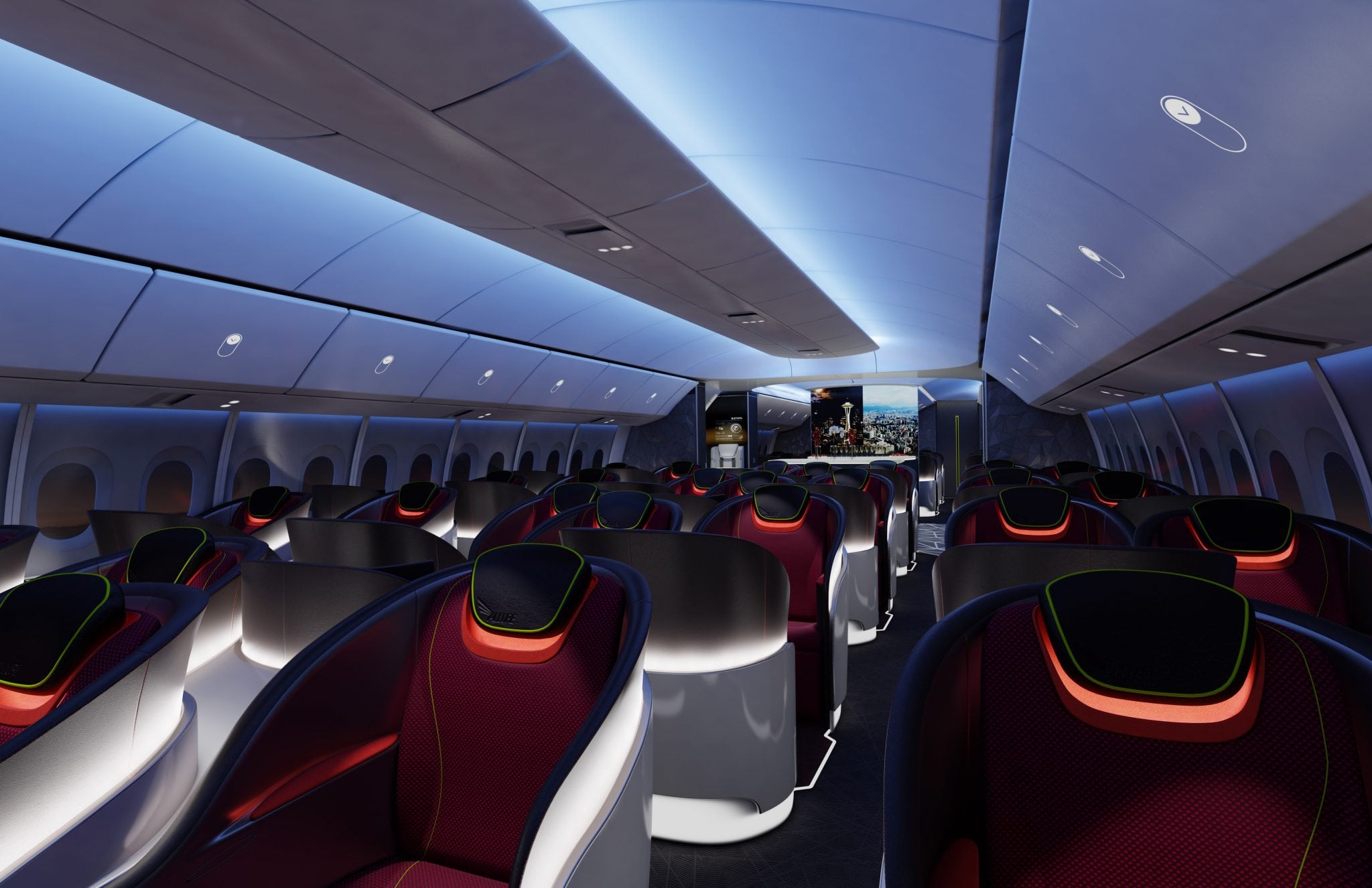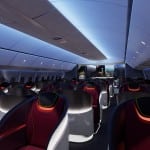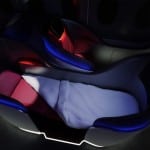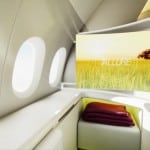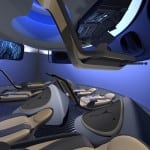Skift Take
The battle for the inch and the battle for the butts-on-seats is -- in the end -- a battle for the birds in the sky.
- 777X interior renderings.
- Rendering of a business class seat onboard the new Boeing 777X.
- Rendering of 777X cabin interior showing surfaces and storage space.
- New larger and higher windows on the 777X will allow more natural ambient light to enter the cabin.
- CST100 commercial interior.
Boeing revealed its design plans for the 777X aircraft during the Farnborough Airshow in England last week. It includes a number of key passenger experiences enhancements and a space-age interior decor.
The new aircraft, Boeing states, will build on the interior of the current 777 and apply a number of successful 787 Dreamliner cabin innovations; including allowing airlines some interesting options for economy class seat widths.
The Battle of the Inch
Airbus made calling for an industry standard of 18″ seats for long-haul flights its corporate cause last year, through its “Comfort without Compromise” campaign. The aircraft manufacturer cited sleep studies to back up its claim that this extra inch increased passenger comfort and well-being. But Boeing has stood firm against snipes pointing out its one-inch seat inferiority on the higher capacity aircraft. Boeing has pointed out that airlines should be free to choose the seat width which best suits their business strategies.
This polemic inch has allowed Airbus to take the high-ground on passenger comfort — but no more.
In its announcement of the passenger experience created for its newest long-haul, twin-aisle airplane–the 777X—Boeing said it “will continue its leadership in offering unprecedented levels of comfort for the traveling public and enhanced flexibility for airlines.”
The union of those two concepts is key. While passengers may be swayed by talks of an extra inch of width onboard, airlines are less likely to find this inch a hot selling point.
On the 777X, though, airlines will be able to provide those 18-inch seats to passengers, without compromising their cabin capacity. Boeing has confirmed that a 10-abreast configuration with 18″ seats is possible on this new aircraft, because the cabin interior of the 777X will be 16-inches “wider than the competition.” The aircraft can accommodate up to 400 passengers, compared to a maximum seating capacity of 369 seats on the A350-1000 (the longest of Airbus’ new extra-wide body A350XWB aircraft)—which is still listed on the Airbus website as “the only all-new aircraft in the 300-400 seat category.”
Adding injury to insult, Boeing also announced that it had managed to increase the capacity on its 737-800 to 200 passengers, bound to make Ryanair very happy. Airbus, who just went through a lot of trouble to increase its A320 capacity to match the former 737-800 capacity of 189 passengers might have been more put out, if the aircraft hadn’t sold so well at Farnborough. The A320 family garnered 369 of the 496 orders Airbus booked at the show. Boeing made light of its poorer showing at Farnborough, stating that it still has the overall advantage on sales of aircraft year-to-date.
Passengers are likely to point out that the 10-abreast seating configuration on the 777X itself is problematic, despite the 18″ width. The logistics of getting in and out of the middle seats of the middle row during a long-haul flight can be a bit uncomfortable, but the final decision on 9-abreast or 10-abreast is up to airlines. Airlines seem to favour the load-factor benefits of 10-abreast aircraft. Even Airbus has left the option of a 10-abreast A350 open.
More Comfort in the New Space
Boeing has made other advances in its design of the 777X interior, which no airline can tamper with, and which will enhance the cabin conditions for passengers. These are features which both Airbus and Boeing have associated with health benefits to frequent flyers and a reduction of jet-lag.
- The 777X will maintain a cabin altitude of 6,000 feet—comparable to the 787 Dreamliner.
- Windows are more than 15 percent larger than the competition and located higher on the fuselage so they’re at eye level for a larger percentage of passengers, allowing increased ambient light to enter the cabin.
- Higher cabin humidity, comparable to the 787 Dreamliner
- Enhanced air filtration, incorporating the latest filtration technologies to increase passengers’ well-being
- Next-generation LED lighting, further enhancing the passenger experience throughout the flight and allowing airlines more branding opportunities.
- Lower cabin noise, achieved through the new engine nacelle design, new high bypass ratio engines, better insulation and a passenger cabin that doubles the number of air nozzles with lower velocity and less noise.
“Boeing has always been committed to exploration and research that leads to the right innovations needed to deliver a superior passenger experience. That commitment has established Boeing as the industry leader in interiors and will extend to the 777X,” said Bob Feldmann, Vice President and General Manager of the 777X Program, when Boeing announced these new cabin features at Farnborough. “We’re already getting very positive feedback from our customers about the 777X’s design concepts, and we think passengers’ preference for the 777-300ER and 787 will continue with the 777X.”
While passengers may be skeptical until they’re onboard the real thing, the new interior design concept of the 777X allows airlines to customize their cabin architectures by class “with an adaptable suite of parts that facilitates choices in overhead ceiling and stow bin configurations.” This will give those aircraft interior designers (both consultants and in-house at the airlines) a lot of room to get creative. Airlines can create separate and distinct cabins that meet both the airline’s product design objectives and satisfy passenger needs by class.
There’s a full tour of the 777X interiors cabin, including Boeing’s vision for the Economy class, on the Boeing New Airplane website.
This Boeing video gives us a sneak-peek:
Spaced-Out
The intersection of design and space has been on the minds of Boeing’s design team this year, with beautiful concepts as a result. Perhaps inspired by the upcoming launch of the Virgin Galactic service, Boeing revealed a new commercial interior of its Crew Space Transportation (CST-100) next-generation manned space capsule this April 30. Showing the world “how people other than NASA astronauts may one day travel to space.”
Boeing partner Bigelow Aerospace showcased a full-scale model of its “BA 330 commercial space habitat,” and it was attractive enough to get us yearning for the days when we might take it for a spin in orbit.
At the time, Chris Ferguson, former Space Shuttle Atlantis commander and current Boeing director of Crew and Mission Operations for the Commercial Crew Program, said: “We are moving into a truly commercial space market and we have to consider our potential customers–beyond NASA–and what they need in a future commercial spacecraft interior.”
Looking at the two designs, the 777X and the CST-100, it is easy to see that the design language from space habitat project carried over into the design of the 777X.
Tomorrow’s Cabin
Inspired by space, creating space, Boeing applies organic curves a feeling of being nested in pods, rather than sitting in boxes. Just how much of this aesthetic Boeing’s customers will adopt is unclear. Hopefully, if we all applaud it loud enough, our cheers will reach the ears of decision makers at the airlines committed to the 777X aircraft. That’s a bit like shouting “I believe!” during a performance of Peter Pan to revive Tinkerbell. It’s all part of the show, it feels good, but Tinkerbell was never really there to begin with so it doesn’t make a difference. A rendering is a rendering is a rendering is a rendering. But, we have some great aircraft interiors designers in the industry—there’s always hope.
Boeing may not be done surprising us on the 777X. Speaking with Skift, Blake Emery, Director, Differentiation Strategy, at Boeing said: “The 777X has many really exciting innovations in it, things I’m not free to talk about—yet. The knowledge we gained from the process we followed on the 787 was invaluable and we continue to find better and better ways to apply those insights on airplanes.”
The Airline Perspective
At the Farnborough airshow, Qatar Airways finalized an order for 50 777-9Xs, valued at $18.9 billion list prices. The airline also announced a commitment for 50 additional 777-9X purchase rights.
Earlier this year, Qatar announced that it will dedicate some aircraft to full business class configurations. Qatar has expressed confidence in increased sales of business class seating, and has incorporated less ostentatious First Class seating than some of its competitors in the Gulf region for its A380 cabins. That gives us some idea of what the 777Xs might look like when they fly.
His Excellency Mr. Akbar Al Baker, CEO of Qatar Airways said of the order: “The Boeing 777 is the backbone of our fleet and is highly amenable to the standards Qatar Airways upholds. We look forward to building on our legacy with the next-generation 777-9X.”
The Daily Newsletter
Our daily coverage of the global travel industry. Written by editors and analysts from across Skift’s brands.
Have a confidential tip for Skift? Get in touch
Tags: airbus, airlines, Boeing, qatar airways
Photo credit: Rendering of 777X cabin interior. Boeing
